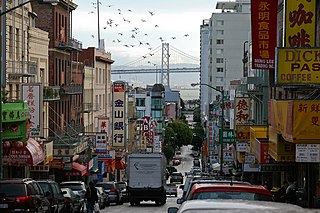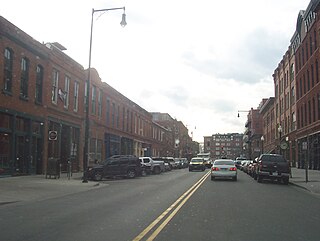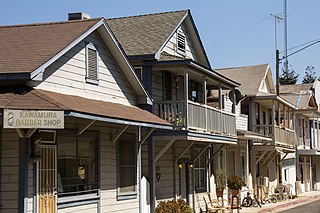Related Research Articles

The Chinatown–International District of Seattle, Washington is the center of the city's Asian American community. Within the district are the three neighborhoods known as Chinatown, Japantown and Little Saigon, named for the concentration of businesses owned by people of Chinese, Japanese and Vietnamese descent, respectively. The geographic area also once included Manilatown.

The Chinatown centered on Grant Avenue and Stockton Street in San Francisco, California, is the oldest Chinatown in North America and one of the largest Chinese enclaves outside Asia. It is also the oldest and largest of the four notable Chinese enclaves within San Francisco. Since its establishment in the early 1850s, it has been important and influential in the history and culture of ethnic Chinese immigrants in North America. Chinatown is an enclave that has retained its own customs, languages, places of worship, social clubs, and identity. There are two hospitals, several parks and squares, numerous churches, a post office, and other infrastructure. Recent immigrants, many of whom are elderly, opt to live in Chinatown because of the availability of affordable housing and their familiarity with the culture. Due to a combination of factors, some more broad-based related to difficult circumstances for San Francisco itself, while other factors are more specific to this neighborhood, San Francisco's Chinatown faces a struggle for survival.

Little Saigon is a name given to ethnic enclaves of expatriate Vietnamese mainly in English-speaking countries. Alternate names include Little Vietnam and Little Hanoi, depending on the enclave's political history. To avoid political undertones due to the renaming of Saigon to Ho Chi Minh City, it is occasionally called by the neutral name Vietnamtown. Saigon is the former name of the capital of the former South Vietnam, where a large number of first-generation Vietnamese immigrants arriving to the United States originate, whereas Hanoi is the current capital of Vietnam.

Chinatown is a neighborhood in Downtown Los Angeles, California, that became a commercial center for Chinese and other Asian businesses in Central Los Angeles in 1938. The area includes restaurants, shops, and art galleries, but also has a residential neighborhood with a low-income, aging population of about 7,800 residents.

Japantown, also known as J-Town or historically as Japanese Town, is a neighborhood in the Western Addition district of San Francisco, California. Japantown comprises about six city blocks and is considered one of the largest and oldest ethnic enclaves in the United States.

Japantown, commonly known as J Town, is a historic cultural district of San Jose, California, north of Downtown San Jose. Historically a center for San Jose's Japanese American and Chinese American communities, San Jose's Japantown is one of only three Japantowns that still exist in the United States, alongside San Francisco's Japantown and Los Angeles's Little Tokyo.

Japantown (日本人街) is a common name for Japanese communities in cities and towns outside Japan. Alternatively, a Japantown may be called J-town, Little Tokyo or Nihonmachi (日本町), the first two being common names for Japantown, San Francisco, Japantown, San Jose and Little Tokyo, Los Angeles.

The Signia by Hilton San Jose is an 805-room high-rise hotel at 170 South Market Street in San Jose, California, located on the Plaza de César Chávez in Downtown San Jose. The hotel opened on April 7, 2022.


Old Town Chinatown is the official Chinatown of the northwest section of Portland, Oregon. The Willamette River forms its eastern boundary, separating it from the Lloyd District and the Kerns and Buckman neighborhoods. It includes the Portland Skidmore/Old Town Historic District and the Portland New Chinatown/Japantown Historic District, which are listed on the National Register of Historic Places. It has been referred to as the "skid row" of Portland.
The Stingaree was a neighborhood of San Diego between the boom of the 1880s and the demolition and vice eradication campaign of 1916. The reason for the neighborhood's fame was its role as the home to the city's "undesirables", including prostitutes, pimps, drug dealers and gamblers. For similar reasons of societal exclusion, it was also the site of the city's first Chinatown. Additionally, the neighborhood was home to many other lower-class citizens, and was in the center of a wider blue-collar residential area encompassing much of the city south of Broadway.

Chinatowns are enclaves of Chinese people outside of China. The first Chinatown in the United States was San Francisco's Chinatown in 1848, and many other Chinatowns were established in the 19th century by the Chinese diaspora on the West Coast. By 1875, Chinatowns had emerged in eastern cities such as New York City, Boston, and Philadelphia. The Chinese Exclusion Act of 1882 barred Chinese immigration to the United States, but the Magnuson Act of 1943 repealed it, and the population of Chinatowns began to rise again. In the 2010s, the downturn in the U.S. economy caused many Chinese Americans to return to China.
As of 2012, 21.4% of the population in San Francisco was of Chinese descent, and there were at least 150,000 Chinese American residents. The Chinese are the largest Asian American subgroup in San Francisco. San Francisco has the highest percentage of residents of Chinese descent of any major U.S. city, and the second largest Chinese American population, after New York City. The San Francisco Area is 7.9% Chinese American, with many residents in Oakland and Santa Clara County. San Francisco's Chinese community has ancestry mainly from Guangdong province, China and Hong Kong, although there is a sizable population of ethnic Chinese with ancestry from other parts of mainland China and Taiwan as well.
There is a Japanese American and a Japanese national population in San Francisco and the San Francisco Bay Area. The center of the Japanese and Japanese American community is in San Francisco's Japantown.

Chinatown in Denver, Colorado, was a residential and business district of Chinese Americans in what is now the LoDo section of the city. It was also referred to as "Hop Alley", based upon a slang word for opium. The first Chinese resident of Denver, Hong Lee, arrived in 1869 and lived in a shanty at Wazee and F Streets and ran a washing and ironing laundry business. More Chinese immigrants arrived in the town the following year. Men who had worked on the construction of the first transcontinental railroad or had been miners in California crossed over the Rocky Mountains after their work was completed or mines were depleted in California.

The Walnut Grove Japanese-American Historic District is a 5-acre (2.0 ha) designated U.S. Historic District in Walnut Grove, California. The bulk of Walnut Grove's Japantown was built in 1915–16 following the 1915 fire which destroyed Walnut Grove's Chinatown. Japantown was depopulated during the forced incarceration of Japanese and Japanese-Americans following the issuance of Executive Order 9066 in 1942, and was re-filled by Filipino and Mexican laborers, who took over work in local orchards and farms during the war. Although the original residents returned to Walnut Grove following the end of World War II, most left within a few years, and the district, with some exceptions, to this day retains the original architecture and style dating back to the 1916 reconstruction.
Barbara L. Voss is an American historical archaeologist. Her work focuses on cross-cultural encounters, particularly the Spanish colonization of the Americas and Overseas Chinese communities in the 19th century, as well as queer theory in archaeology and gender archaeology. She is an associate professor of anthropology at Stanford University.

Old Chinatown, or original Chinatown, is a retronym that refers to the location of a former Chinese-American ethnic enclave enforced by legal segregation that existed near downtown Los Angeles, California in the United States from the 1860s until the 1930s. Old Chinatown included the former Calle de los Negros and extended east across Alameda Street to Apablasa, Benjamin, Jeannete, Juan, Marchessault, and Macy Streets. This Chinatown was at its commercial and communal peak between 1890 and 1910.
Heinlenville was a Chinese-American ethnic enclave in San Jose, California. Established in 1887 and demolished in 1931, it was the last and longest-lasting of San Jose's five Chinatowns.
Market Street Chinatown or Plaza Chinatown refers to two successive Chinatowns in San Jose, California, during the 19th century. Both were destroyed by arson with the tacit support of officials. The site was rediscovered during a 1980s redevelopment project, shedding light on an era when San Jose led the state of California in anti-Chinese violence.
References
- 1 2 Gong-Guy, Lillian; Wong, Gerrye (2007). Chinese in San Jose and the Santa Clara Valley. ISBN 9780738547770.
- ↑ Potter, Laura; Yamane, Maya; Mau, Matthew; Lister, Brianna (June 2011). "San Jose Chinatowns Heritage Fair" (PDF). Market Street Chinatown Archaeological Project. Retrieved October 15, 2021.
- 1 2 Pfaelzer, Jean (2007). Driven Out: The Forgotten War Against Chinese Americans . New York City: Random House. ISBN 9781588366405.
- 1 2 Voss 2003, p. 13.
- ↑ Voss 2003, pp. 13–14.
- 1 2 "San Jose apologizes for Chinatown destruction in 1887". Los Angeles Times. Associated Press. September 28, 2021. Retrieved September 29, 2021.
- 1 2 3 4 Voss 2003, p. 14.
- ↑ Carlson, Eric. "San Jose City Hall". Soft Underbelly of San Jose. Boulevards. Retrieved July 3, 2018.
- 1 2 3 4 "Woolen Mills Chinatown". San Jose, California: Chinese Historical and Cultural Project. Retrieved October 23, 2023.
- ↑ Michaels, Gina (June 2005). "Peck-Marked Vessels from the San José Market Street Chinatown: A Study of Distribution and Significance". International Journal of Historical Archaeology. 9 (2): 123–134. doi:10.1007/s10761-005-8143-6. S2CID 161761697.
- ↑ Voss 2003, p. 5.
- ↑ McAllister, Sue (June 1, 2012). "Artifacts exhibited from a long-buried Market Street Chinatown in San Jose". Mercury News. San Jose, California. Retrieved September 29, 2021.
- ↑ Duran, Doug; Pizarro, Sal; Chu, Anda (October 6, 2021). "Photos: San Jose holds ceremony to apologize to the Chinese community for past wrongs". The Mercury News . San Jose, California. Retrieved October 22, 2023.
- ↑ Staff report (May 30, 2001). "Stories of pride over prejudice". Los Altos Town Crier . Los Altos, California. Retrieved October 23, 2023.
- ↑ Praetzellis, Mary; Praetzellis, Adrian (2011). "Cultural Resource Management Archaeology and Heritage Values". Historical Archaeology . Society for Historical Archaeology. 45 (1): 86–100.
- 1 2 3 Yu, Connie Young (Fall 2016). "Chinatown & Japantown San José" (PDF). Californian. No. 43. Cupertino, California: California History Center & Foundation at De Anza College. pp. 6–12.
- ↑ Voss 2003, p. 15.
- 1 2 Praetzellis, Adrian; Praetzellis, Mary; Costello, Julia; Duval, Charlene; Yu, Connie Young; Harris, Ben; Kaijankoski, Philip; Koenig, Heidi; Meyer, Michael D.; Mischke, Bryan; Much, Bryan; Ribeiro, Maria; Solari, Elaine-Maryse; Stewart, Suzanne; Waghorn, Annita (April 2008). Historical Context And Archaeological Survey Report: Heinlenville/San José Corporation Yard Archaeological Project, San José, California (Report). Anthropological Studies Center, Sonoma State University . Retrieved September 29, 2021.
- ↑ "Chinese American Historical Museum". San Jose, California: Chinese Historical and Cultural Project. Retrieved September 29, 2021.
- ↑ "Chinese American Historical Museum at the Ng Shing Gung". San Jose, California: History San José. June 16, 2023. Retrieved October 22, 2023.